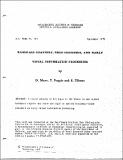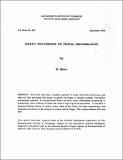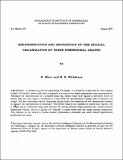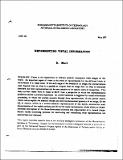Browsing AI Memos (1959 - 2004) by Author "Marr, D."
Now showing items 1-15 of 15
-
Analysis of a Cooperative Stereo Algorithm
Marr, D.; G. Palm,; Poggio, T. (1977-10-01)Marr & Poggio (1976) recently described a cooperative algorithm that solves the correspondence problem for stereopsis. This article uses a probabilistic technique to analyze the convergence of that algorithm, and ... -
Analysis of Occluding Contour
Marr, D. (1976-10-01)Almost nothing can be deduced about a general 3-D surface given only its occluding contours in an image, yet contour information is easily and effectively used by us to infer the shape of a surface. Therefore, implicit ... -
Analyzing Natural Images: A Computational Theory of Texture Vision
Marr, D. (1975-06-01)A theory of early and intermediate visual information processing is given, which extends to about the level of figure-ground separation. Its core is a computational theory of texture vision. Evidence obtained from ... -
Bandpass Channels, Zero-Crossings, and Early Visual Information Processing
Marr, D.; Poggio, T.; Ullman, S. (1978-09-01)A recent advance by B.F. Logan in the theory of one octave bandpass signals may throw new light on spatial-frequency-tuned channels in early visual information processing. -
Cooperative Computation of Stereo Disparity
Marr, D.; Poggio, T. (1976-06-01)The extraction of stereo disparity information from two images depends upon establishing a correspondence between them. This article analyzes the nature of the correspondence computation, and derives a cooperative algorithm ... -
Directional Selectivity and Its Use in Early Visual Processing
Marr, D.; Ullman, S. (1979-06-01)The construction of directionally selective units and their use in the processing of visual motion are considered. -
Early Processing of Visual Information
Marr, D. (1975-12-01)The article describes a symbolic approach to visual information processing, and sets out four principles that appear to govern the design of complex symbolic information processing systems. A computational theory of ... -
Evidence for a Fifth, Smaller Channel in Early Human Vision
Marr, D.; Hildreth, E.; Poggio, T. (1979-08-01)Recent studies in psychophysics and neurophysiology suggest that the human visual system utilizes a range of different size or spatial frequency tuned mechanisms in its processing of visual information. It has been ... -
From Understanding Computation to Understanding Neural Circuitry
Marr, D.; Poggio, T. (1976-05-01)The CNS needs to be understood at four nearly independent levels of description: (1) that at which the nature of computation is expressed; (2) that at which the algorithms that implement a computation are characterized; ... -
Representation and Recognition of the Spatial Organization of Three Dimensional Shapes
Marr, D.; Nishihara, H.K. (1977-05-01)The human visual process can be studied by examining the computational problems associated with deriving useful information from retinal images. In this paper, we apply this approach to the problem of representing ... -
Representation and Recognition of the Spatial Organization of Three-Dimensional
Marr, D.; Nishihara, H.K. (1976-08-01)A method is given for representing 3-D shapes. It is based on a hierarchy of stick figures (called 3-D models), where each stick corresponds to an axis in the shape's generalized cone representation. Although the ... -
Representing Visual Information
Marr, D. (1977-05-01)Vision is the construction of efficient symbolic descriptions from images of the world. An important aspect of vision is the choice of representations for the different kinds of information in a visual scene. In the ... -
Spatial Disposition of Axes in a Generalized Cylinder Representation of Objects
Marr, D.; Hishihara, H.K. (1975-12-01)It is proposed that the 3-D representation of an object is based primarily on a stick-figure configuration, where each stick represents one or more axes in the object's generalized cylinder representation. The loosely ... -
Theory of Edge Detection
Marr, D.; Hildreth, E. (1979-04-01)A theory of edge detection is presented. -
A Theory of Human Stereo Vision
Marr, D.; Poggio, T. (1977-11-01)An algorithm is proposed for solving the stereoscopic matching problem. The algorithm consists of five steps: 1.) Each image is filtered with bar masks of four sizes that vary with eccentricity; the equivalent filters ...















